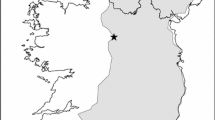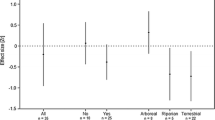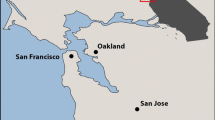Abstract
Invasive species–species that have successfully overcome the barriers of transport, introduction, establishment, and spread—are a risk to biodiversity and ecosystem function. Introduction effort is one of the main factors underlying invasion success, but life history traits are also important as they influence population growth. In this contribution, we first investigated life history traits of the Barbary ground squirrel, Atlantoxerus getulus, a species with a very low introduction effort. We then studied if their invasion success was due to a very fast life history profile by comparing their life history traits to those of other successful invasive mammals. Next, we examined whether the number of founders and/or a fast life history influences the invasion success of squirrels. Barbary ground squirrels were on the fast end of the “fast-slow continuum”, but their life history was not the only contributing factor to their invasion success, as the life history profile is comparable to other invasive species that do not have such a low introduction effort. We also found that neither life history traits nor the number of founders explained the invasion success of introduced squirrels in general. These results contradict the concept that introduction effort is the main factor explaining invasion success, especially in squirrels. Instead, we argue that invasion success can be influenced by multiple aspects of the new habitat or the biology of the introduced species.




Similar content being viewed by others
Availability of data and material
The datasets analysed during the current study are available in the Github repository, https://github.com/annemarievdmarel/lifehistory_invasion (https://doi.org/10.5281/zenodo.4136880).
Code availability
The code used during the current study are available in the Github repository, https://github.com/annemarievdmarel/lifehistory_invasion (https://doi.org/10.5281/zenodo.4136880).
References
Allen WL, Street SE, Capellini I (2017) Fast life history traits promote invasion success in amphibians and reptiles. Ecol Lett 20:222–230. https://doi.org/10.1111/ele.12728
Aulagnier S, Gouat P, Thévenot M (2013) Atlantoxerus getulus Barbary ground squirrel. In: Happold DCD (ed) Mammals of Africa, vol III. Bloomsbury Publishing, London, pp 43–44
Bañares A, Blanca G, Güemes J et al (2003) Atlas y Libro Rojo de la Flora Vascular Amenazada de España. Dirección General de Conservación de la Naturaleza, Madrid
Barkalow FS, Soots RF (1975) Life span and reproductive longevity of the gray squirrel Sciurus c. carolinensis Gmelin. J Mamm 56:522–524
Basso R, Vannuccini ML, Nerva L et al (2019) Multiple origins of the common chameleon in southern Italy. Herpetozoa 32:11–19. https://doi.org/10.3897/herpetozoa.32.e35611
Bellard C, Cassey P, Blackburn TM (2016) Alien species as a driver of recent extinctions. Biol Lett 12:20150623. https://doi.org/10.1098/rsbl.2015.0623
Benitez VV, Almada Chavez S, Gozzi AC et al (2013) Invasion status of Asiatic red-bellied squirrels in Argentina. Mamm Biol 78:164–170. https://doi.org/10.1016/j.mambio.2012.10.002
Bertolino S (2009) Animal trade and non-indigenous species introduction: the world-wide spread of squirrels. Divers Distrib 15:701–708. https://doi.org/10.1111/j.1472-4642.2009.00574.x
Bertolino S, Lurz PWW (2013) Callosciurus squirrels: worldwide introductions, ecological impacts and recommendations to prevent the establishment of new invasive populations. Mamm Rev 43:22–33. https://doi.org/10.1111/j.1365-2907.2011.00204.x
Bertolino S, Sciandra C, Bosso L et al (2020) Spatially explicit models as tools for implementing effective management strategies for invasive alien mammals. Mamm Rev 50:187–199. https://doi.org/10.1111/mam.12185
Bielby J, Mace GM, Bininda-Emonds ORP et al (2007) The fast-slow continuum in mammalian life history: An empirical reevaluation. Am Nat 169:748–757. https://doi.org/10.1086/516847
Blackburn TM, Pyšek P, Bacher S et al (2011) A proposed unified framework for biological invasions. Trends Ecol Evol 26:333–339. https://doi.org/10.1016/j.tree.2011.03.023
Blackburn TM, Lockwood JL, Cassey P (2015) The influence of numbers on invasion success. Mol Ecol 24:1942–1953. https://doi.org/10.1111/mec.13075
Bürkner PC (2017) brms: An R package for Bayesian multilevel models using Stan. J Stat Softw. https://doi.org/10.18637/jss.v080.i01
Bürkner PC (2018) Advanced Bayesian multilevel modeling with the R package brms. R J 10:395–411. https://doi.org/10.32614/rj-2018-017
Capellini I, Baker J, Allen WL et al (2015) The role of life history traits in mammalian invasion success. Ecol Lett 18:1099–1107. https://doi.org/10.1111/ele.12493
Carere C, Gherardi F (2013) Animal personalities matter for biological invasions. Trends Ecol Evol 28:5–6. https://doi.org/10.1016/j.tree.2012.10.006
Chapple DG, Simmonds SM, Wong BBM (2012) Can behavioral and personality traits influence the success of unintentional species introductions? Trends Ecol Evol 27:57–62. https://doi.org/10.1016/j.tree.2011.09.010
Chapuis J-L, Obolenskaya E, Pisanu B, Lissovsky A (2011) Datasheet on Tamias sibiricus. In: CABI, Wellingford, UK. https://www.cabi.org/isc/datasheet/62788. Accessed 19 Dec 2020
Charnov EL (1982) The theory of sex allocation. Princeton University Press, Princeton
Christensen R, Kleindorfer S (2009) Jack-of-all-trades or master of one? Variation in foraging specialisation across years in Darwin’s Tree Finches (Camarhynchus spp.). J Ornithol 150:383–391. https://doi.org/10.1007/s10336-008-0358-y
Colautti RI, Ricciardi A, Grigorovich IA, MacIsaac HJ (2004) Is invasion success explained by the enemy release hypothesis? Ecol Lett 7:721–733. https://doi.org/10.1111/j.1461-0248.2004.00616.x
Colautti RI, Grigorovich IA, MacIsaac HJ (2006) Propagule pressure: A null model for biological invasions. Biol Invasions 8:1023–1037. https://doi.org/10.1007/s10530-005-3735-y
Culina A, Linton DM, Pradel R et al (2019) Live fast, don’t die young: Survival-reproduction trade-offs in long-lived income breeders. J Anim Ecol. https://doi.org/10.1111/1365-2656.12957
Dlugosch KM, Parker IM (2008) Founding events in species invasions: genetic variation, adaptive evolution, and the role of multiple introductions. Mol Ecol 17:431–449. https://doi.org/10.1111/j.1365-294X.2007.03538.x
Dobson FS, Oli MK (2007a) Fast and slow life histories of mammals. Ecoscience 14:292–299. https://doi.org/10.1139/z11-033
Dobson FS, Oli MK (2007b) Fast and slow life histories of rodents. In: Wolff JO, Sherman PW (eds) Rodent societies. An ecological and evolutionary perspective. The University of Chicago Press, Chicago, pp 99–105
Doherty TS, Glen AS, Nimmo DG et al (2016) Invasive predators and global biodiversity loss. Proc Natl Acad Sci USA 113:11261–11265. https://doi.org/10.1073/pnas.1602480113
Estoup A, Ravigné V, Hufbauer R et al (2016) Is there a genetic paradox of biologicl invasion? Annu Rev Ecol Evol Syst 47:51–72. https://doi.org/10.1146/annurev-ecolsys-121415-032116
Fisher DO, Owens IPF (2004) The comparative method in conservation biology. Trends Ecol Evol 19:391–398. https://doi.org/10.1016/j.tree.2004.05.004
Forsyth DM, Duncan RP, Bomford M, Moore G (2004) Climatic suitability, life-history traits, introduction effort, and the establishment and spread of introduced mammals in Australia. Conserv Biol 18:557–569
Fox J, Weisberg S (2011) An {R} companion to applied regression, second edition. SAGE Publications, Inc
Gabry J, Simpson D, Vehtari A et al (2019) Visualization in Bayesian workflow. J R Stat Soc 182:389–402. https://doi.org/10.1111/rssa.12378
Gallardo B, Clavero M, Sánchez MI, Vilà M (2016) Global ecological impacts of invasive species in aquatic ecosystems. Glob Chang Biol 22:151–163. https://doi.org/10.1111/gcb.13004
Gangoso L, Donázar JA, Scholz S et al (2006) Contradiction in conservation of island ecosystems: plants, introduced herbivores and avian scavengers in the Canary Islands. Biodivers Conserv 15:2231–2248. https://doi.org/10.1007/s10531-004-7181-4
Groh K, García A (2004) Phylum Mollusca. In: Izquierdo I, Martín JL, Zurita N, Arechavaleta M (eds) Lista de especies silvestres de Canarias (hongos, plantas y animales terrestres). Consejería de Medio Ambiente y Ordenación Territorial, Gobierno de Canarias, pp 149–154
Hayes KR, Barry SC (2008) Are there any consistent predictors of invasion success? Biol Invasions 10:483–506. https://doi.org/10.1007/s10530-007-9146-5
Holway DA, Suarez AV (1999) Animal behavior: an essential component of invasion biology. Trends Ecol Evol 14:328–330. https://doi.org/10.1016/S0169-5347(99)01636-5
Hutterer R (2008) Crocidura canariensis. In: IUCN Red List Threat. Species. www.iucnredlist.org. Accessed 20 Feb 2015
IPBES (2019) Global assessment report on biodiversity and ecosystem services of the Intergovernmental Science-Policy Platform on Biodiversity and Ecosystem Services. Brondizio ES, Settele J, Díaz S, Ngo HT (eds). IPBES Secretariat, Bonn, Germany
IUCN (2008) Atlantoxerus getulus. In: IUCN Red List Threat. Species. https://www.iucnredlist.org. Accessed 16 Dec 2020
Jones KE, Bielby J, Cardillo M et al (2009) PanTHERIA: a species-level database of life history, ecology, and geography of extant and recently extinct mammals. Ecology 90:2648–2648. https://doi.org/10.1890/08-1494.1
Keller SR, Taylor DR (2010) Genomic admixture increases fitness during a biological invasion. J Evol Biol 23:1720–1731. https://doi.org/10.1111/j.1420-9101.2010.02037.x
Kolar CS, Lodge DM (2001) Progress in invasion biology: predicting invaders. Trends Ecol Evol 16:199–204
Koprowski JL (2002) Handling tree squirrels with a safe and efficient restraint. Wildl Soc Bull 30:101–103
Kratzer KV, van der Marel A, Garroway C et al (2020) Evidence for an extreme founding effect in a highly successful invasive species. bioRxiv. https://doi.org/10.1101/2020.08.04.236695
Lawton C, Cowan P, Bertolino S et al (2010) The consequences of introducing non-indigenous species: two case studies, the grey squirrel in Europe and the brushtail possum in New Zealand. Rev Sci Tech Off Int Epiz 29:287–298. https://doi.org/10.1097/JTO.0b013e31828b5228
Le Roux JJ, Wieczorek AM, Meyer JY (2008) Genetic diversity and structure of the invasive tree Miconia calvescens in Pacific islands. Divers Distrib 14:935–948. https://doi.org/10.1111/j.1472-4642.2008.00504.x
Liu C, Comte L, Olden JD (2017) Heads you win, tails you lose: Life-history traits predict invasion and extinction risk of the world’s freshwater fishes. Aquat Conserv Mar Freshw Ecosyst 27:773–779. https://doi.org/10.1002/aqc.2740
Lockwood JL, Cassey P, Blackburn T (2005) The role of propagule pressure in explaining species invasions. Trends Ecol Evol 20:223–228. https://doi.org/10.1016/j.tree.2005.02.004
Lodge D (1993) Biological invasions: lessons for ecology. Trends Ecol Evol 8:133–136
López-Darias M (2007) Ecology of invasions: the case of the Barbary ground squirrel (Atlantoxerus getulus) in Fuerteventura Island (Canary Islands). PhD thesis, University of La Laguna. San Cristóbal de La Laguna, Spain
López-Darias M (2008) Atlantoxerus getulus Linnaeus, 1758. http://www.interreg-bionatura.com/especies/pdf/Atlantoxerus getulus.pdf. Accessed 18 Jan 2019
López-Darias M, Lobo JM (2008) Factors affecting invasive species abundance: the Barbary Ground Squirrel on Fuerteventura Island, Spain. Zool Stud 47:268–281
López-Darias M, Nogales M (2008) Effects of the invasive Barbary ground squirrel (Atlantoxerus getulus) on seed dispersal systems of insular xeric environments. J Arid Environ 72:926–939. https://doi.org/10.1016/j.jaridenv.2007.12.006
López-Darias M, Nogales M (2016) Raptors as legitimate secondary dispersers of weed seeds. Ibis 158:428–432. https://doi.org/10.1111/ibi.12360
López-Darias M, Lobo JM, Gouat P (2008a) Predicting potential distributions of invasive species: the exotic Barbary ground squirrel in the Canarian archipelago and the west Mediterranean region. Biol Invasions 10:1027–1040. https://doi.org/10.1007/s10530-007-9181-2
López-Darias M, Ribas A, Feliú C (2008b) Helminth parasites in native and invasive mammal populations: comparative study on the Barbary ground squirrel Atlantoxerus getulus L. (Rodentia, Sciuridae) in Morocco and the Canary Islands. Acta Parasitol 53:296–301. https://doi.org/10.2478/s11686-008-0036-5
Lorenzo-Morales J, López-Darias M, Martínez-Carretero E, Valladares B (2007) Isolation of potentially pathogenic strains of Acanthamoeba in wild squirrels from the Canary Islands and Morocco. Exp Parasitol 117:74–79. https://doi.org/10.1016/j.exppara.2007.03.014
Machado A (1979) The introduction of the Getulian squirrel (Atlantoxerus getulus L., 1758) in Fuerteventura, Canary Islands. Egypt J Wildl Nat Resour 2:182–202
Machado A, Domínguez F (1982) Estudio sobre la presencia de la Ardilla Moruna (Atlantoxerus getulus L.) en la isla de Fuerteventura; su introducción, su biología y su impacto en el medio. Santa Cruz de Tenerife, Spain
Markula A, Hannan-Jones M, Csurhes S (2016) Invasive animal risk assessment - Indian myna Acridotheres tristis. Department of Agriculture and Fisheries, State of Queensland, Australia.
Medina FM, López-Darias M, Nogales M, García R (2008) Food habits of feral cats (Felis silvestris catus L.) in insular semiarid environments (Fuerteventura, Canary Islands). Wildl Res 35:162–169. https://doi.org/10.1071/WR07108
Medina FM, Bonnaud E, Vidal E et al (2011) A global review of the impacts of invasive cats on island endangered vertebrates. Glob Chang Biol 17:3503–3510. https://doi.org/10.1111/j.1365-2486.2011.02464.x
Merkel A (2019) Climate data. https://en.climate-data.org/. Accessed 29 Jan 2019
Merrick MJ, Koprowski JL (2017) Should we consider individual behavior differences in applied wildlife conservation studies? Biol Conserv 209:34–44. https://doi.org/10.1016/j.biocon.2017.01.021
Mori E, Milanesi P, Menchetti M et al (2018a) Genetics reveals that free-ranging chipmunks introduced to Italy have multiple origins. Hystrix 29:239–242. https://doi.org/10.4404/hystrix-00116-2018
Mori E, Zozzoli R, Menchetti M (2018b) Global distribution and status of introduced Siberian chipmunks Eutamias sibiricus. Mamm Rev 48:139–152. https://doi.org/10.1111/mam.12117
Mori E, Menchetti M, Zozzoli R, Milanesi P (2019) The importance of taxonomy in species distribution models at a global scale: the case of an overlooked alien squirrel facing taxonomic revision. J Zool 307:43–52. https://doi.org/10.1111/jzo.12616
Pettitt BA, Waterman JM, Wheaton CJ (2008) Assessing the effects of resource availability and parity on reproduction in female Cape ground squirrels: resources do not matter. J Zool 276:291–298. https://doi.org/10.1111/j.1469-7998.2008.00491.x
Piquet JC, López-Darias M, van der Marel A et al (2018) Unraveling behavioral and pace-of-life syndromes in a reduced parasite and predation pressure context: personality and survival of the Barbary ground squirrel. Behav Ecol Sociobiol 72:147. https://doi.org/10.1007/s00265-018-2549-8
Promislow DEL, Harvey PH (1990) Living fast and dying young: a comparative analysis of life-history variation among mammals. J Zool Soc Lond 220:417–437
R Core Team (2017) R: a language and environment for statistical computing. R Foundation for Statistical Computing, Vienna, Austria. https://www.R-project.org/
R Core Team (2020) R: a language and environment for statistical computing. R Foundation for Statistical Computing, Vienna, Austria. https://www.R-project.org/
Ralls K, Ballou J (1982) Effect of inbreeding on juvenile mortality in some small mammal species. Lab Anim 16:159–166. https://doi.org/10.1258/002367782781110151
Ralls K, Brugger K, Ballou J (1979) Inbreeding and juvenile mortality in small populations of ungulates. Science 206:1101–1103
Réale D, Garant D, Humphries MM et al (2010) Personality and the emergence of the pace-of-life syndrome concept at the population level. Phil Trans R Soc B 365:4051–4063. https://doi.org/10.1098/rstb.2010.0208
Rihane A, El Hamoumi R, El Agbani MA et al (2019) Expansion of the North African ground squirrel Atlantoxerus getulus (Rodentia) along the Moroccan Mid-Atlantic Plains. Mammalia 83:150–156. https://doi.org/10.1515/mammalia-2017-0150
Rolland J, Condamine FL, Jiguet F, Morlon H (2014) Faster speciation and reduced extinction in the tropics contribute to the mammalian latitudinal diversity gradient. PLoS Biol 12:e1001775. https://doi.org/10.1371/journal.pbio.1001775
Ryan CP, Anderson WG, Gardiner LE, Hare JF (2012) Stress-induced sex ratios in ground squirrels: Support for a mechanistic hypothesis. Behav Ecol 23:160–167. https://doi.org/10.1093/beheco/arr169
Sæther B, Engen S, Pape Møller A et al (2004) Life history variation predicts the effects of demographic stochasticity on avian population dynamics. Am Nat 164:793–802. https://doi.org/10.1086/425371
Signorile AL, Wang J, Lurz PWW et al (2014) Do founder size, genetic diversity and structure influence rates of expansion of North American grey squirrels in Europe? Divers Distrib 20:918–930. https://doi.org/10.1111/ddi.12222
Sih A, Bell AM, Johnson JC, Ziemba RE (2004) Behavioral syndromes: an integrative overview. Q Rev Biol 79:241–277
Simberloff D (2009) The role of propagule pressure in biological invasions. Annu Rev Ecol Evol Syst 40:81–102. https://doi.org/10.1146/annurev.ecolsys.110308.120304
Simberloff D, Martin JL, Genovesi P et al (2013) Impacts of biological invasions: What’s what and the way forward. Trends Ecol Evol 28:58–66. https://doi.org/10.1016/j.tree.2012.07.013
Sol D, Bacher S, Reader SM, Lefebvre L (2008) Brain size predicts the success of mammal species introduced into novel environments. Am Nat 172:S63–S71. https://doi.org/10.1086/588304
Sol D, Maspons J, Vall-llosera M et al (2012) Unraveling the life history of successful invaders. Science 337:580–583. https://doi.org/10.1126/science.1221523
Stearns SC (1983) The influence of size and phylogeny on patterns of covariation among life-history traits in the mammals. Oikos 41:173–187
Therneau TM (2015) A package for survival analysis in S. https://cran.r-project.org/package=survival. Accessed 13 Nov 2017
Therneau TM, Grambsch PM (2000) Modeling survival data: Extending the {C}ox model. Statistics for Biology and Health. Springer New York, New York
Traveset A, Nogales M, Alcover JA et al (2009) A review on the effects of alien rodents in the Balearic (western Mediterranean sea) and Canary islands (eastern Atlantic ocean). Biol Invasions 11:1653–1670. https://doi.org/10.1007/s10530-008-9395-y
Vahsen ML, Shea K, Hovis CL et al (2018) Prior adaptation, diversity, and introduction frequency mediate the positive relationship between propagule pressure and the initial success of founding populations. Biol Invasions 20:2451–2459. https://doi.org/10.1007/s10530-018-1713-4
van der Marel A (2020) annemarievdmarel/lifehistory_invasion v10. Zenodo. https://doi.org/10.5281/zenodo.4136880
van der Marel A, López-Darias M, Waterman JM (2019) Group-enhanced predator detection and quality of vigilance in a social ground squirrel. Anim Behav 151:43–52. https://doi.org/10.1016/j.anbehav.2019.02.017
van der Marel A, Waterman JM, López-Darias M (2020) Social organization in a North African ground squirrel. J Mamm 101:670–683. https://doi.org/10.1093/jmammal/gyaa031
van Wilgen NJ, Richardson DM (2012) The roles of climate, phylogenetic relatedness, introduction effort, and reproductive traits in the establishment of non-native reptiles and amphibians. Conserv Biol 26:267–277. https://doi.org/10.1111/j.1523-1739.2011.01804.x
Vehtari A, Gelman A, Gabry J (2017) Practical Bayesian model evaluation using leave-one-out cross-validation and WAIC. Stat Comput 27:1413–1432. https://doi.org/10.1007/s11222-016-9696-4
Waterman JM (1996) Reproductive biology of a tropical, non-hibernating ground squirrel. J Mamm 77:134–146
Wood DJA, Koprowski JL, Lurz PWW (2007) Tree squirrel introduction: a theoretical approach with population viability analysis. J Mamm 88:1271–1279. https://doi.org/10.1644/06-MAMM-A-303.1
Acknowledgements
We thank the owners of our study sites for access to their lands, the Cabildo of Fuerteventura for access at the Estación Biológica de la Oliva, and the IPNA-CSIC for logistical support. We thank E. Anjos for providing useful feedback.
Funding
This study was funded by a University of Manitoba Faculty of Science graduate studentship and a Faculty of Graduate Studies Graduate Enhancement of the Tri-Council Stipend (GETS) to AM, by Cabildo de Tenerife, Program TF INNOVA 2016–21 (with MEDI & FDCAN Funds) (P. INNOVA 2016–2021) to MLD, and the Natural Sciences and Engineering Research Council of Canada (#04362), the Canadian Foundation for Innovation, and the University of Manitoba University Research Grant Program to JMW.
Author information
Authors and Affiliations
Contributions
AM, JMW and MLD conceived and designed the study and collected the data. AM analyzed the data and first drafted the manuscript; the contributions of AM, JMW and MLD made up the final manuscript.
Corresponding author
Ethics declarations
Conflict of interest
The authors declare that they have no conflict of interest.
Ethical approval
All procedures conformed to the guidelines of the American Society of Mammalogists for the use of wild mammals in research, were approved by the University of Manitoba Animal Care and Use Committee (protocol #F14-032) and were permitted by the government of Fuerteventura (Cabildo Insular de Fuerteventura #14885).
Consent for publication
All authors whose names appear on the submission approved the version to be published.
Additional information
Communicated by Mathew Samuel Crowther.
Supplementary Information
Below is the link to the electronic supplementary material.
Rights and permissions
About this article
Cite this article
van der Marel, A., Waterman, J.M. & López-Darias, M. Exploring the role of life history traits and introduction effort in understanding invasion success in mammals: a case study of Barbary ground squirrels. Oecologia 195, 327–339 (2021). https://doi.org/10.1007/s00442-021-04853-7
Received:
Accepted:
Published:
Issue Date:
DOI: https://doi.org/10.1007/s00442-021-04853-7




